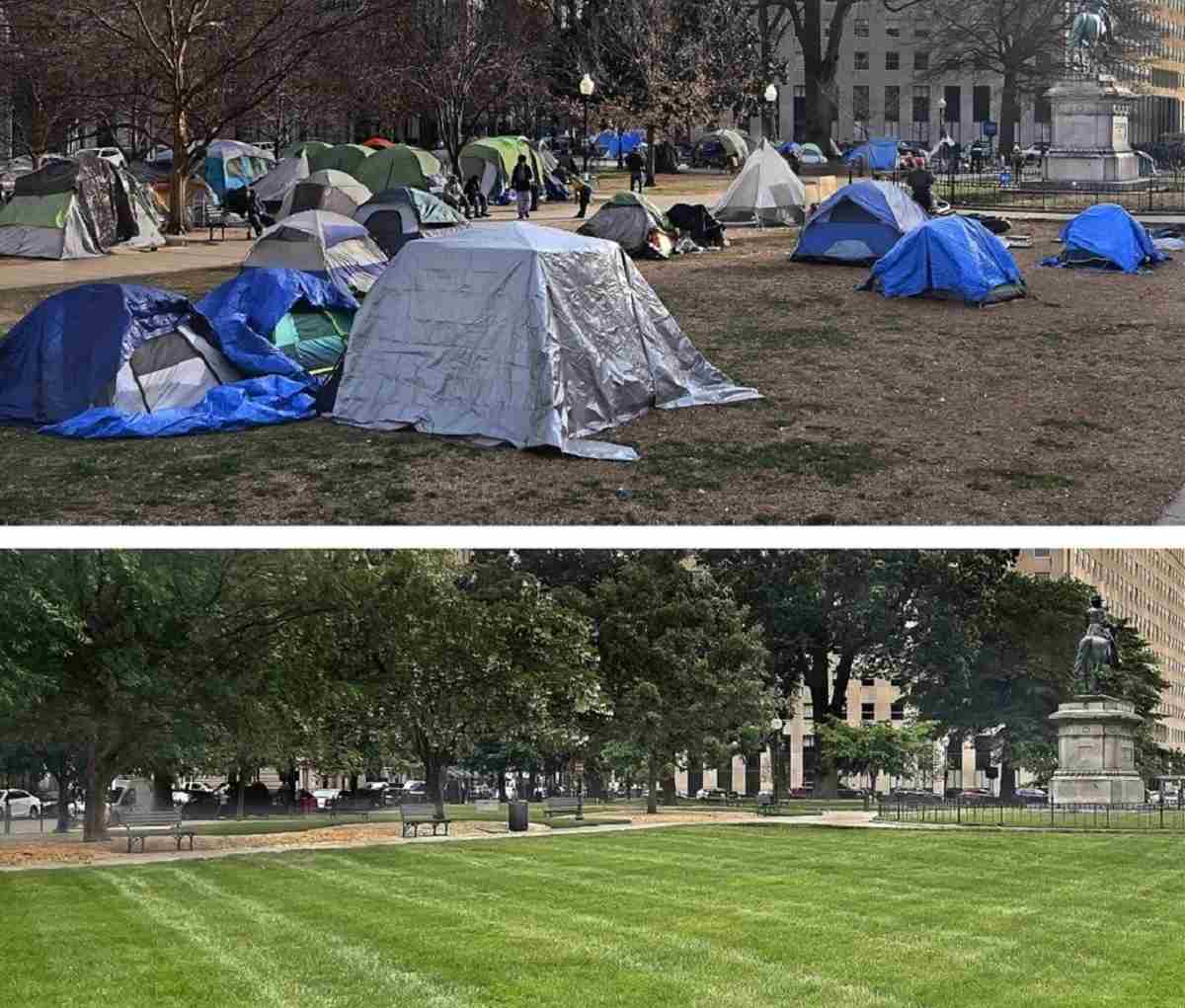
At top, McPherson Square in Washington, D.C., on Feb. 11, 2023. At bottom, the same view on May 7, 2023, after the homeless people were cleared out and the park was refurbished.
14:02 JST, July 6, 2023
The people and the tents where they lived are gone from McPherson Square.
That means when tourists and area residents now pass by the park in Washington, D.C. – a short walk from the White House – they no longer have to see what it looks like to live without housing in the nation’s capital.
They can sit on an open bench and not think about the body that curled up there the night before as rats scurried by.
They can walk along the sidewalk to get lunch without having to consider whether the people they pass might be hungry.
They can leave the park feeling good and believing the city has its chronic homelessness problem under control.
Except it doesn’t.
That cleared park is not a success story. It only appears that way if you don’t look too closely.
A success story would have meant that all, or at least most, of the people who were living in that park were provided housing before workers tossed what wasn’t packed and carried away into a trash compactor. A success story would have meant that city officials had invested enough in mental health care, affordable housing and opportunities for people with criminal records to offer people who lived in that park a real chance at changing their circumstances. A success story would have meant making lives filled with struggle easier, not harder.
But that’s not what my Washington Post colleagues Marissa J. Lang and Michael S. Williamson found when they went in search of the people who had been living in McPherson Square. They found that most of the 75 or so people who were pushed out of the park in February remained unhoused, and some had been forced to move as many as six times.
They found a 62-year-old woman named Sharon K. Brown pleading with officials who were ordering her to leave another spot: “I have no help, nowhere to go. You’re telling me I have to leave, but how? Go where? Please, help me.”
Lang wrote this in an article that told what happened to Brown and others: “City data shows that D.C. has increasingly leaned on an emergency protocol to displace unsheltered adults with little notice. This practice has largely been used to clear solo campers, even those in the District’s most far-flung corners.”
The article went on to explain the concerns with those swift encampment clearings and offer the city’s response: “Advocates say the practice, known as an ‘immediate disposition,’ has made it harder for outreach workers to keep track of individuals and connect them to services. It also makes it virtually impossible for unhoused residents to assert their rights or challenge the city’s actions, lawyers said. City officials, who have been unable to contain the rapid spread of encampments since the start of the pandemic, say the increase in emergency clearings indicates a rise in health and safety hazards among those who live on the street – not a shift in D.C. enforcement.”
No one wants to see people living in tents in parks. We would all rather see that green space open to the public, and people sleeping in beds instead of on the ground. Chronic homelessness is hard to witness and dangerous to experience. It causes people to die in premature and preventable ways. In D.C. last year, more than 70 people died while unhoused. Some of the causes: intoxication, hypothermia and homicide. The youngest person who died was 30. Others who died were 31, 32, 36, 41 and 45.
If we didn’t know what happened to those people at McPherson Square, we could tell ourselves that their situations had improved. But we now know better.
We know that the city not only failed to pull most of them out of homelessness, it has pushed some of them into situations that have made them less visible and more vulnerable. Advocates have warned that the continual and rapid encampment sweeps can cause individuals to lose important documents and contact with people who can help them. The article explained that some of the former occupants of McPherson Square had been approved for housing vouchers but risked getting displaced again before they could be matched with a caseworker or an apartment.
Last year, according to the article, the city cleared 96 encampment sites, and 60 percent of them were done using immediate dispositions. This year, the city is on pace to exceed that number.
I walk by McPherson Square every time I go to The Post’s building, and one afternoon, during the second year of the pandemic, I found myself sitting at a nearby restaurant, drinking lattes with a man who had slept in the park. As we talked, he placed on the table proof that he had contributed to society: a sheet of paper that showed he had served four years in the military and received an outstanding-unit award and Good Conduct Medal before he was granted an honorable discharge.
“I loved the military,” he told me. He also told me how he ended up sitting for hours on a bench nearby and eventually sleeping there. His mother was walking across a street when a driver hit her. Her death, he said, caused him to lose motivation, jobs and eventually his apartment.
“I died that day myself,” he told me. “That was my person. I had no ambition after that.”
Homelessness is a complex issue, made even more so by trauma, mental illness and addictions. But when you talk to people who have experienced it – and I have talked to many over the years and shared their stories with you – you start to understand how someone ends up in that state. You also start to hope that officials see them as people and not problems.
No one expects D.C. to end homelessness. But the city has the resources, leadership and public support to serve as an example to other places on how to humanely address encampments. But first, city officials have to recognize that what they are doing is not working. By forcing people in tents to move again and again – and again and again and again and again – they are pushing the people who most need help further from it.
That’s the dirty truth about a clean park.
"News Services" POPULAR ARTICLE
-

American Playwright Jeremy O. Harris Arrested in Japan on Alleged Drug Smuggling
-

Japan’s Nikkei Stock Average as JGB Yields, Yen Rise on Rate-Hike Bets
-

Japan’s Nikkei Stock Average Licks Wounds after Selloff Sparked by BOJ Hike Bets (UPDATE 1)
-

Japanese Bond Yields Zoom, Stocks Slide as Rate Hike Looms
-

Japan’s Nikkei Stock Average Buoyed by Stable Yen; SoftBank’s Slide Caps Gains (UPDATE 1)
JN ACCESS RANKING
-

Keidanren Chairman Yoshinobu Tsutsui Visits Kashiwazaki-Kariwa Nuclear Power Plant; Inspects New Emergency Safety System
-

Imports of Rare Earths from China Facing Delays, May Be Caused by Deterioration of Japan-China Relations
-

University of Tokyo Professor Discusses Japanese Economic Security in Interview Ahead of Forum
-

Japan Pulls out of Vietnam Nuclear Project, Complicating Hanoi’s Power Plans
-

Govt Aims to Expand NISA Program Lineup, Abolish Age Restriction



























